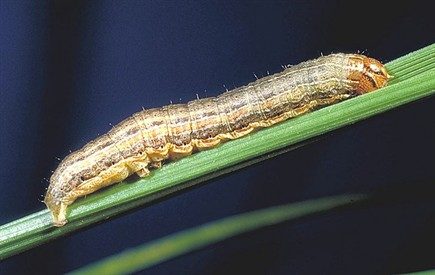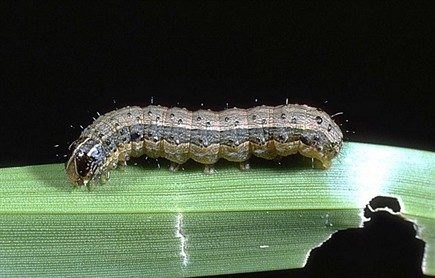The "Armyworm" caterpillars often March through Turf Eating Everything in their Path
Caterpillars a semitropical pest on both cool and warm season turfgrasses. One group is known as the armyworms, which go by names like armyworm, fall armyworm (Spodoptera frugiperda), cluster cutworm, etc. The one mentioned here is the fall armyworm.
The fall armyworm can cause damage to short cut turf found on golf course greens, and tees. During mid-summer populations can grow to such huge number that en masse they can literally "mow off" grass in fair-ways, roughs and on sports fields. They commonly eat anything green leaving only a few stems in their wake.
On short cut turf like greens, symptoms normally appear quite similar to black cut-worms - grazing on the leaf blades resulting in small circular sunken marks. If high populations of fall armyworm develop the greens will first appear rather ragged looking but quickly all the green tissue will be removed.
Fall armyworms are the larvae (damaging stage) of moths. They have complete life cycles with egg, larval (caterpillar), pupal and adult stages.
In semi-tropical and tropical regions all stages of the fall armyworm are present during the year resulting in a constant threat to the turf.
Insecticide Treatment Strategies
Curative Treatments. Numerous organophosphate, carbamate, pyrethroid and diacylhydrazine insecticides effectively control armyworms in turf. On golf course greens and tees, it is recommended that spraying a band of turf surrounding the affected area (a minimum of one boom or spreader width) will help keep larvae from moving back onto the greens from surrounding turf.
Preventive Treatments
Field tests with neonicotinoid in-secticides (usually long resid-ual systemic insecticides) have shown that some applied to golf course greens or tees provided suppression of armyworms for about 30 days. Other systemic insecticides may have effective residual effects of 14 to over 90 days.
Picture 1 (below): The common armyworm (Pseudaletia unipuncta)

Picture 1 (below): The fall armyworm (Spodoptera frugiperda)

